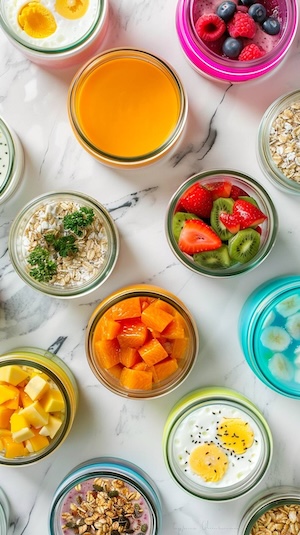Best Cereal for PCOS: Brands Ranked & Reviewed
Discover the best cereal for PCOS with our expert rankings. Compare brands, check ingredients, and find PCOS friendly cereal that supports hormonal balance.
How to make this beautiful and delicious multilayer Korean rice cake. The written recipe and photos and tips are posted on my website. http://www.maangchi.com/recipe/mujigae-ddeok I'm going to introduce a beautiful Korean rice cake today. It's called mujigae ddeok (무지개떡). Mujigae means rainbow, so my ancestors must have got the idea for the name from a rainbow! I love it! This is an example of how they incorporated natural beauty into their everyday life. Even though the name of the rice cake is "rainbow rice cake," it is usually made with only 3-5 different colored layers. That's why this rice cake is sometimes called "colorful rice cake" (색떡, saekddeok). In this recipe, I am using 5 different colors from bottom to top: brown, green, yellow, pink, and white. This rice cake is made on special occasions like a baby's 1 year old birthday, or a wedding. As you see in this video, making this rice cake takes a lot of effort and time, even though the ingredients are comparatively simple. However, if you make this rice cake for someone very special in your life, you wouldn't care much about time and effort. : ) You may wish this while you're rubbing the rice flour with your palms: "I wish my baby becomes healthy, smart, and a good, warm-hearted person!" "I wish my parents have healthy and long life!" "To show my love for my lovely husband (or wife) !" Leave a comment and let me know what you wish when you make this! Cooking time: 1.5 hours Ingredients: A 2 pound package of frozen rice flour, sugar, salt, water, liquid food coloring (green, pink, and yellow), lemon, mugwort powder (ssukgaru 쑥가루), cocoa powder. Cooking utensils: Steamer, sifter, 8 inch (20 cm) ring or springform. Directions: 1.Thaw out frozen rice flour package and put it into a large bowl. 2. Sift the rice flour. 3. Add 10 cups of water in the bottom of a steamer, and place a wet cloth over the rack. 4. Place the 8 inch cake ring in the center of the rack. Brown layer (the bottom layer): 1. Place 1 cup of rice flour in a medium sized bowl. Add 1 ts cocoa powder, a pinch of salt, 2 tbs of white sugar, and 4 ts of water. 2. Mix it all up and press out any wet lumps by rubbing the lumps gently between your palms. 3. Put the mixture into a sifter and sift into the center of the ring. 4. Flatten out the mixture so it sits level in the ring. *tip: a business card works well Green layer: 1.Place 1½ cup of rice flour in a medium sized bowl. Add a pinch of salt, 2 tbs sugar, and 1 ts mugwort powder (ssukgaru). *tip: you can replace mugwort powder with green tea powder 2. Put 2 tbs of water and 1 drop of green liquid food coloring into a small bowl and mix well. *tip: Use a chopstick to get a very little amount of the food coloring 3. Add the green water to the rice cake mixture and mix it all up. Press out any wet lumps by rubbing the lumps gently between your palms. 4. Put the mixture into a sifter and sift into the center of the ring. 5. Flatten out the mixture so it sits level in the ring. Yellow layer: 1.Place 1½ cup of rice flour in a medium sized bowl. Add a pinch of salt and 2 tbs sugar. 2. Put 1tbs lemon juice, 1 tbs water, and 1 drop of yellow liquid food coloring into a small bowl and mix well. 3. Add the yellow water to the rice cake mixture and mix it all up. Press out any wet lumps by rubbing the lumps gently between your palms. 4. Put the mixture into a sifter and sift into the center of the ring. 5. Flatten out the mixture so it sits level in the ring. Pink layer: 1. Place 1½ cup of rice flour in a medium sized bowl. Add a pinch of salt and 2 tbs sugar. 2. Put 2 tbs water and 1 drop of hot pink (fuchsia) liquid food coloring into a small bowl and mix well. 3. Add the pink water to the rice cake mixture and mix it all up. Press out any wet lumps by rubbing the lumps gently between your palms. 4. Put the mixture into a sifter and sift into the center of the ring. 5. Flatten out the mixture so it sits level in the ring. White layer (the top layer): 1. Place 1 cup of rice flour in a medium sized bowl. Add a pinch of salt, 2 tbs white sugar, and 4 ts water. 2. Mix it up and press out any wet lumps by rubbing the lumps gently between your palms. 3. Put the mixture into a sifter and sift into the center of the ring. 4. Flatten out the mixture so it sits level in the ring. Now let's garnish! 1.On the top of the cake place 5 dried cranberries to make flower petals. Put a few pine nuts in the center. 2.Cut a dried apricot into a thin strip, and place it as a flower stem. Finally, let's steam it: 1.Close the lid of the steamer and bring to a boil for 30 minutes over high heat. 2. Turn down the heat and simmer another 5 minutes. 3. Take out the rice cake and let it cool down. Serve with tea or coffee.
This recipe includes superfoods such as:
Lemon, Cranberries, Green Tea, Nuts
Transform your health with tailored 7-day meal plans designed specifically for PCOS management. Just $7/month or $59/year.
Get it now →See video for ingredients
See video for instructions

You know the drill: Alarm goes off. You hit snooze. Rush around frantically. Skip breakfast AGAIN because there's no time. By 10am, you're hangry, your blood sugar is all over the place, and your PCOS symptoms are already acting up.
Sound familiar?
Finally – a meal prep system designed specifically for women with PCOS who refuse to let chaotic mornings derail their health goals.
In just ONE hour on Sunday, you can transform your entire week:
"I went from skipping breakfast 4 days a week to having delicious, hormone-supporting meals ready every morning. My energy is more stable and my cravings have disappeared!"
– Sarah M.
Stop letting chaotic mornings control your health.
Get your hormone-happy mornings starting this Sunday.
→ Get Your 60-Minute Solution Now
Transform your health with tailored 7-day meal plans designed specifically for PCOS management. Just $7/month or $59/year.
Get it now →Serving Size: 0
| Amount Per ONE Serving | ||
|---|---|---|
| Calories 0 kcal | ||
| Fat 0 g | ||
| Carbohydrate 0 g | ||
| Protein 0 g | ||
💡 Introducing the 10/10 PCOS Solution:
Ten Delicious Crockpot Recipes that take just 10 minutes to prep!
Say goodbye to hours in the kitchen and hello to clean, PCOS-friendly meals made effortlessly.
👉 Click here to grab your 10/10 PCOS Solution today! Try The 10/10 PCOS Solution: Ten Crockpot Recipes That Take Just Ten Minutes to Prep
Managing PCOS can be challenging, but you don't have to do it alone. Join our supportive community to connect with others who understand what you're going through, share tips, and get encouragement. Here's how you can get involved:
Subscribe to our Newsletter: Receive PCOS-friendly recipes, tips, research updates, and more delivered straight to your inbox. Stay informed and empowered with the latest information and support.
Join our Telegram Channel: Stay updated with the latest tips and advice on managing PCOS.
Follow PCOS Meal Planner on Facebook: Engage with our community, participate in discussions, and get support from others.
Break the cycle with the PCOS Meal Planner - your personalized guide to eating better, feeling better, and managing PCOS symptoms. Take control today!

Forget the frustrating cycle of weight loss attempts, endless medications, and living in discomfort. Introducing the PCOS Meal Planner. A meal planning guide that goes beyond temporary fixes to offer a comprehensive strategy, empowering you to ignite a transformation towards lasting health and happiness. Step into a world where you control your PCOS, not the other way around.
Unlock Your PCOS Freedom Now.
Discover the best cereal for PCOS with our expert rankings. Compare brands, check ingredients, and find PCOS friendly cereal that supports hormonal balance.
Learn how to transition away from fruit when starting a ketogenic diet for PCOS. Discover gradual strategies, fruit alternatives, and practical tips for success.
Discover 5 delicious PCOS banana bread recipes with low-glycemic ingredients. Learn how to make hormone-friendly banana bread that supports blood sugar balance.
Creatine for women with PCOS explained simply. Learn safety, benefits, hormone effects, tips, and how creatine may support PCOS symptoms naturally.
Complete PCOS diet plan with foods to eat, foods to avoid, meal timing, and real results. Learn the science-backed approach to managing PCOS through diet, with 7-day meal plan, grocery list, and step-by-step implementation guide. Based on clinical research and real patient outcomes.
Complete guide to ordering at Wendy's with PCOS. Discover the best protein-focused meals, what to skip, and how to customize orders to keep blood sugar stable. Learn which burgers, salads, and sides work for PCOS, plus complete macros for every menu item and smart swaps to avoid insulin spikes.
Complete guide to ordering at Burger King with PCOS. Discover the best protein-focused meals, what to skip, and how to customize orders to keep blood sugar stable. Learn which burgers, salads, and sides work for PCOS, plus complete macros for every menu item and smart swaps to avoid insulin spikes.
Discover 30+ delicious PCOS-friendly smoothie recipes that stabilize blood sugar and support hormones. Each recipe includes protein macros, glycemic load, and hormone-balancing ingredients. Find breakfast smoothies, post-workout options, green smoothies, and dessert alternatives - all designed to prevent insulin spikes while satisfying cravings.
Discover the best supplements for PCOS backed by clinical research. Learn which supplements improve insulin resistance, reduce androgens, support ovulation, and balance hormones. Complete guide with dosages, timing, brands, and what to avoid. Evidence-based recommendations for inositol, vitamin D, omega-3, berberine, and more.